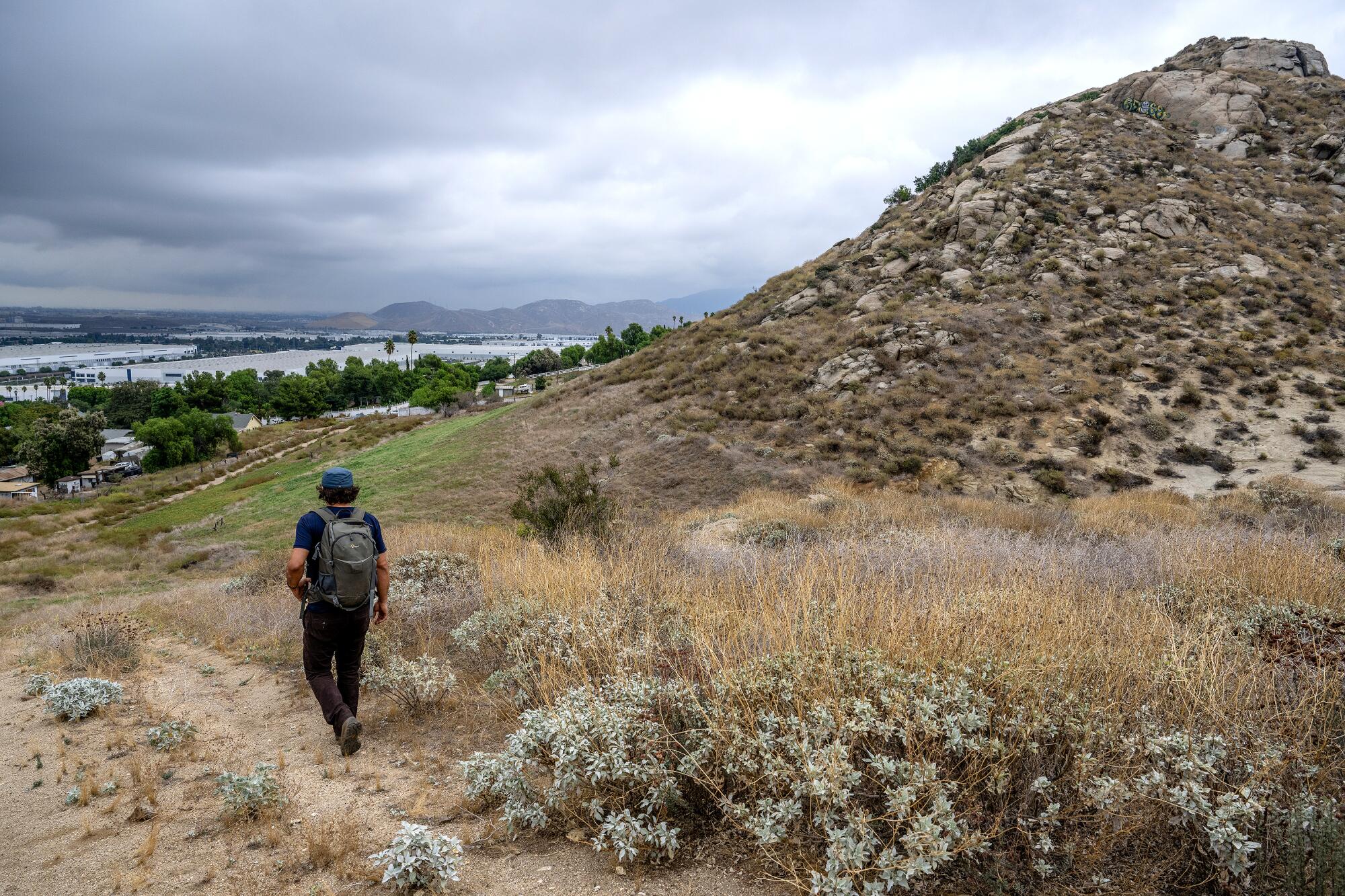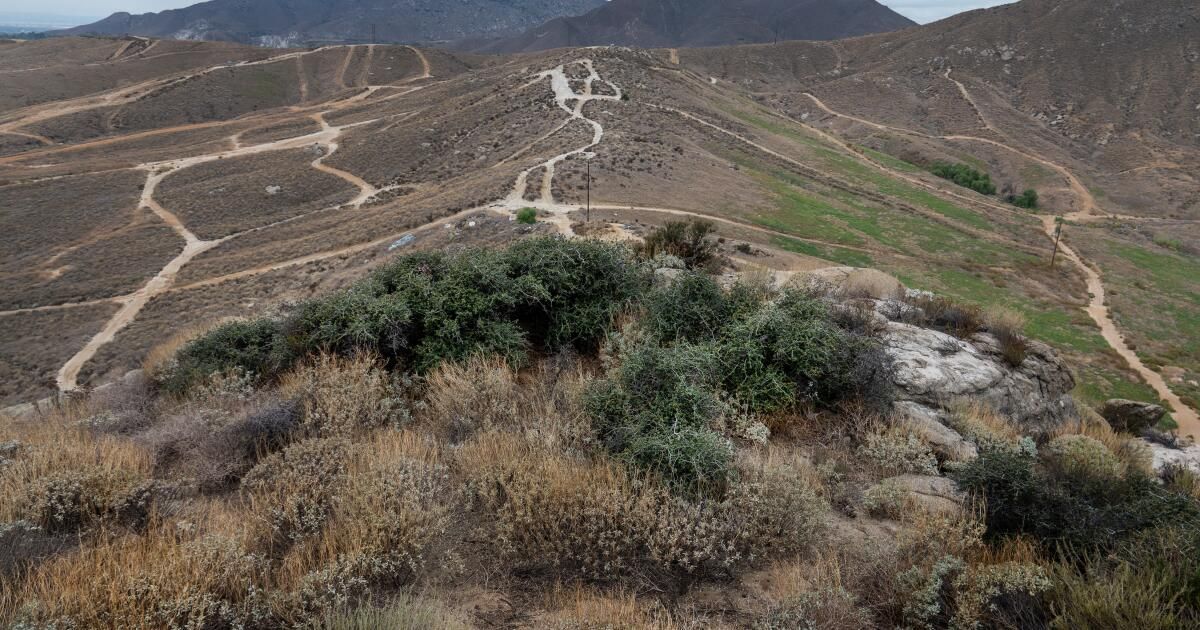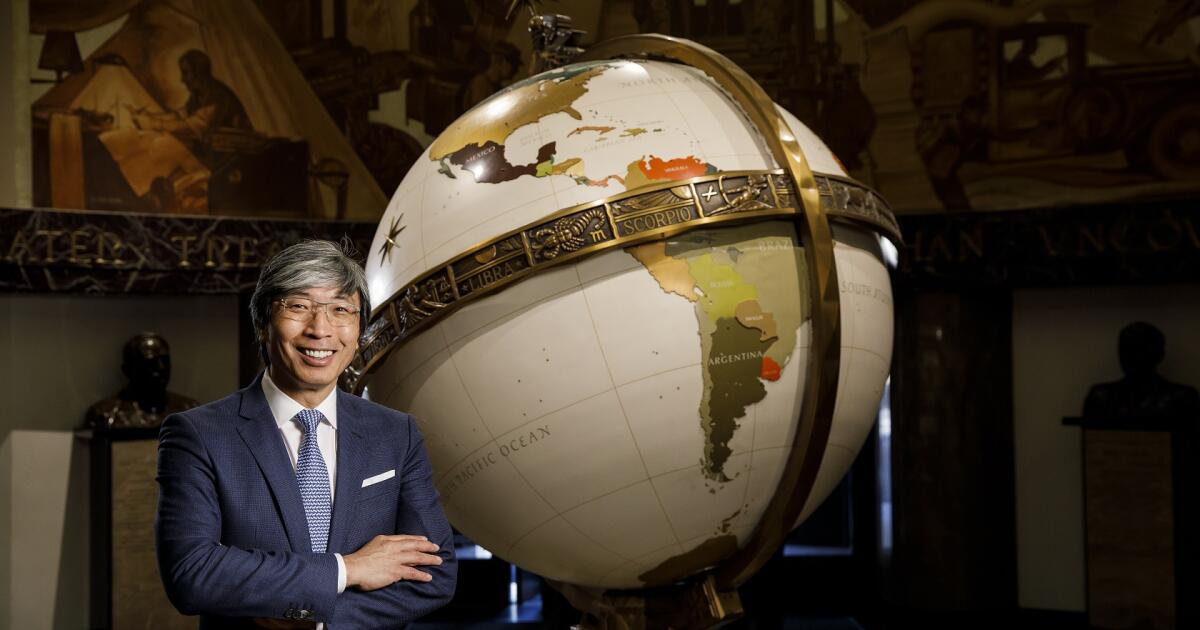An oak palm tree in Jurupa Valley is estimated to be between 13,000 and 18,000 years old. The plant, which looks like a sprawling, dark green shrub, is now at the center of a battle over its development.
(Aaron Echols)
JURUPA VALLEY, California.
After a contentious five-hour public meeting, environmental advocates have persuaded Inland Empire officials to delay development of a project within 400 feet one of the oldest known plants in the state and the third oldest in the world.
“Tonight has been a real learning process,” said Jurupa Valley City Planning Commission Chair Penny Newman at Thursday’s meeting. “I think we all need time to process the information we received here tonight.”
The commission voted unanimously to postpone the vote. Commissioners said the developers should conduct more studies on potential effects on the plant, a Palmer oak, and further explore protective measures. Commissioners also requested more details on a plan to transfer ownership of the tree and surrounding lands to a local tribe, which would oversee its preservation.
“We have discovered a world-class treasure here in our humble town,” said Jennifer Iyer, a lifelong Jurupa Valley resident, at the meeting. “In a town known for its toxic waste dump and the worst air quality in the country … let’s have a plan that protects and celebrates something unique that we can be proud of.”
The roughly 370-acre project would include residential housing, an elementary school, a business park and industrial buildings. The tree would be located on an 27-acre rock outcrop, but would be 400 feet from the plant. Scientists and tribal members say the oak has been around for at least 13,000 years, surviving the last ice age and, more recently, the founding of the United States.
Members of the Shiishongna Tongva Nation, Crown Band of Gabrieleño Indians, and the Kizh Nation, Gabrieleño Band of Mission Indians, have also lived in the Santa Ana River basin for millennia. Both groups consider the tree to be sacred.
“We’ve known about this tree forever,” said Michael Negrete, chief and president of the Shiishongna Tongva Nation. “It provides medicine, it gives oxygen, it gives life to animals.”
Companies have been trying to develop the land. from the early 1990swith Richland Communities submitting the current plan in 2019. After discussions with the City Planning Commission and the public, it replaced potential warehouses with light industrial space and a business park, increased the amount of open space, and committed to transferring ownership and conservation responsibilities for the land with the Palmer oak to a Native tribe or conservation organization.
Richland Communities announced at the meeting that it had reached a conceptual agreement to transfer the land to the Kizh Nation and provide them with an initial $250,000 grant for conservation. Company executives also proposed requiring that the agreement be finalized before construction begins on the industrial and commercial sections, which are closest to the tree.
Commissioners want additional information about the details of the plan and how conservation of the land would be legally enforced. Richland Communities did not respond to a request for comment.
Compared to the robust live oaks of California, the Palmer oak is more shrub-like and consists of individual stems sprouting in a grove. It was only relatively recently that researchers determined its impressive age.
Mitchell Provance, a botanist and research associate at the University of California, Riverside, first noticed the oak more than two decades ago and thought it was odd that it lived isolated from other members of its species in an area that was much lower and hotter than where trees typically grow. He began discussing the tree with his colleagues. They hypothesized that it was the last remnant of a time when the region was cooler and wetter — a much friendlier environment for oaks.
To test this, the researchers collected samples from several dead trunks, and sure enough, they all had identical DNA. Each time the tree was damaged by fire, it would sprout again from the base of its trunk. By using tree rings to estimate how much the trunk can grow in a year, the team was able to calculate the age of the tree by measuring the diameter of the forest.
Today, the forest is 24 metres wide, leading researchers to estimate the tree is between 13,000 and 18,000 years old. It is possible that the tree could have reproduced itself, rather than simply sprouting from the trunk to produce clones, but this is unlikely, experts say.
While the company has worked with environmental consultant FirstCarbon Solutions to study the impact of construction vibrations on the tree and identify potential water sources, it has not mapped the tree's root system or confirmed its direct water source, a process that would involve chemical testing of the water on the roots of the oak.
Some also worry that the proposed development exposes the old oak tree to the urban heat island effect, a phenomenon in which developed areas can operate. 1 to 7 degrees higher than natural shaded areas during the day.
Aaron Echols, conservation chair of the California Native Plant Society of Riverside/San Bernardino, said it was the duty of conservation groups to point out potential effects on the tree that have not yet been studied. “The responsibility to mitigate impacts … falls on the applicant and the consultant.”

Environmentalist Aaron Echols walks along a dirt path in front of a giant hill where the Palmer oak tree stands. The development would extend to the base of the hill.
(Gina Ferazzi/Los Angeles Times)
The portion of the environmental impact study that analyzes the Palmer oak, including its exact location, has been removed from public documents. The city was required to do so by law, as the tree has sensitive cultural significance to native tribes. As a result, independent scientists have not been able to analyze the report.
The city said it would explore “creative ways” to legally allow a select few outside experts to view and discuss the report.












